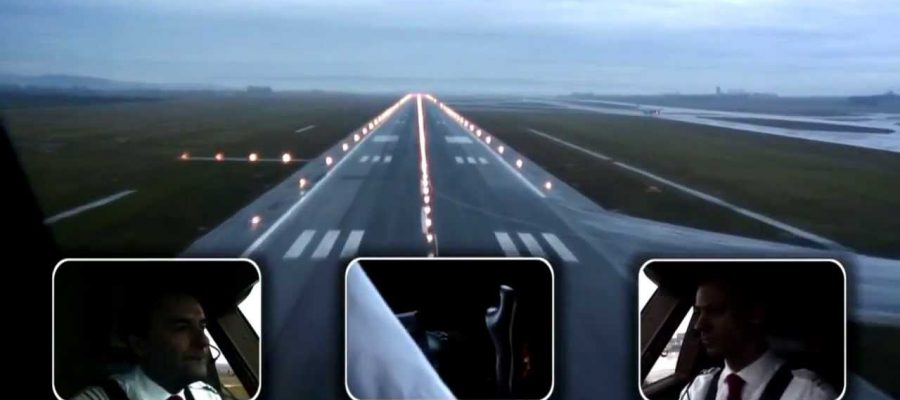Wien-Schwechat International Airport
Vienna, the capital city of Austria, has the largest airport in the country, with a volume of 22½ million passengers per year and more than a quarter of million tons of cargo in 2015. To manage that particular feat they engaged in 227,000 aircraft movements (both landing and departing). This means they operate 24 hours per day, and engage in 25 operations per hour, or over 600 per day. It’s a busy place.
To top it off they accomplish it with just two runways, 16/34 and 11/29, at 3600 metres and 3500 metres, respectively (2+ miles each). Under perfect conditions the runways are capable of 74 flight movements per hour because unlike some runways with different directions, these two meet at a corner instead of crossing in the middle.
The old fashioned way, with runways crossed at the centre, was designed as an “either/or” situation depending on the wind. It was often a space consideration as well. With this particular layout flight paths for the two runways do not have to cross if the winds are favorable.
The airport and Lower Austria, the state where the Vienna airport is situated, are in legal conflict with protesters/environmentalists that do not want a third runway added. The air traffic in the area is on the rise and a third runway seems necessary. They are still in legal limbo awaiting a decision from the court.
Looking Around
If you want to have a look around the airport they have a panoramic webcam which refreshes automatically every 10 minutes. It has clickable hot spots (see if you can find “Satan” in the image!) including an historical ability which allows you to see the entire surrounding area except for about 15° due north of the airport.
At the current time they’re engaging in the construction of the Baufeld Moxy Hotel. If you reverse the history you can see that it was once all parking-lot, but will soon provide a huge on-airport facility for travelers.
Now here’s a particularly high quality video, showing not only the landing itself, but the pilot & co-pilot as they react to situations (Gear Down at 2:54, shutting down the autopilot when they are below 1,000 feet, etc.) with cool calm and competence. For those with anxiety about flying, seeing these professionals, going through their paces is probably going to be very reassuring.
To add that extra layer of reality, don’t forget to check out the Flight Radar. If you’re a fan of Air Traffic Control you can watch the skies around Vienna Airport here. Clicking on any plane will identify it for you, showing its origin, destination, which airline and its associated with, and its flight path, and the colours tell you that when you have selected a particular airport, in this instance LOWW/VIE, that the blue aircraft are inbound to Vienna, the green aircraft have departed from Vienna, and the grey are simply passing through the airspace without interacting with the Vienna Airport.
Historical Information
This facility began its life as a military Airport in 1938 in consideration of the political turmoil in Europe at that time. It was used as the Heinkel-Süd (south) facility for designing and building aircraft for the military.
In 1954 the operating company for the airport was founded and this new facility replaced the Aspern Airfield (built in 1912) as Austria’s principle Airport. At that time and only had one runway but it was 3000 m (9800 feet) long. It wasn’t until 1972 when they added a second runway, and another 10 years before a proper connection was made between the Airport and the Ostautobahn (national highway system).
As the volume of passengers continued to grow through the 1980s the airport expanded. They enlarged the arrivals terminal in 1986 and added the new Eastern Pier with eight jet bridges two years later. In 1992 they opened the new Terminal One, and in 1993 a large shopping plaza serving the concourses B, C, and D. In 1995 the Western Pier came into operation with a dozen new jet bridges.
They weren’t finished yet, because in 2006 they added a control tower overlooking the entire airport because of its immense 109 m (358 ft.) stature. Still not satisfied, they equipped the control tower with a laser light show that they present at night which passengers can see from the plane as they approach the airport.
2006 saw the addition of a VIP/general aviation terminal, with both a discrete and discreet apron. A three year project finished in 2007 where they open a brand new office park offering 6.9 hectares (17 acres) of rentable office space!
The new Terminal Three, added in 2012, will allow them to process as many as 30,000,000 passengers per year, and many more aircraft with 17 additional jet bridges.
Getting to and from the airport is relatively easy with four different train services. As mentioned, the airport has its own entrance/exit to the highway system, so rental cars or taxis are an option, as well as buses.
Incidents
There’s only been one fatal incident at the airport, and that was back in 1955 when a plane with 29 occupants descended below minimum on its approach to the airport and crashed. There were seven fatalities.
The Takeaway
Always trying to make the travel experience more fun, or at least less taxing for parents, LOWW/VIE provides play areas for kids to burn off some energy. One area has a slide, a jungle gym, a maze, and a place for parents to sit.
Another area is a video wall where kids can jump up and down and try to catch objects that are flying cross a screen. It’s not supervised by airport staff, but that’s your job as a parent. Let’s burn off that energy!
